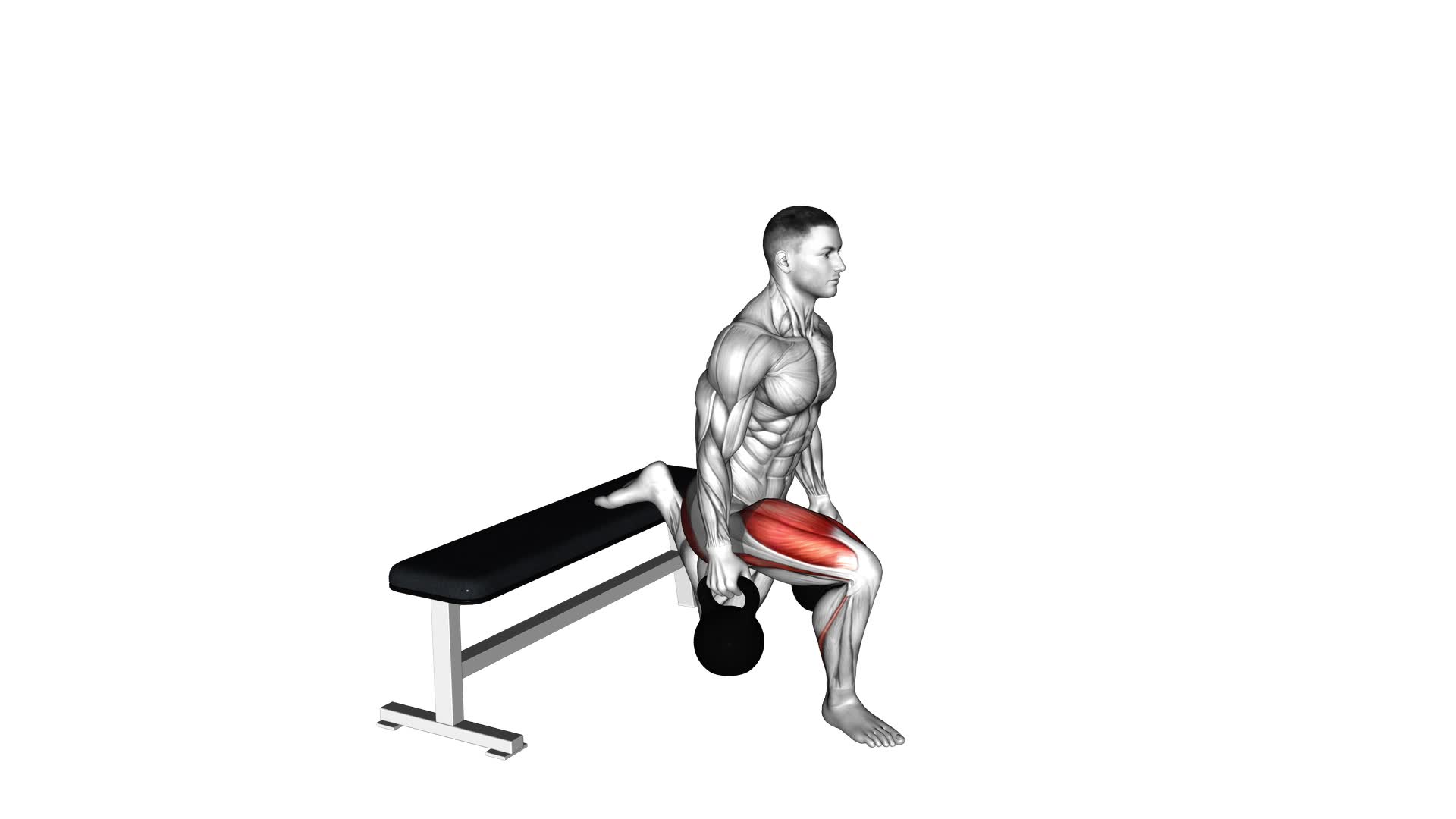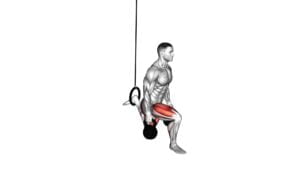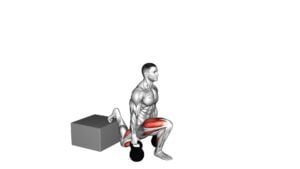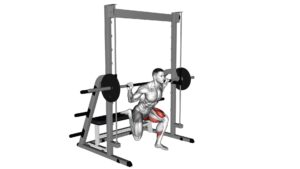Kettlebell Single Leg Split Squat – Video Exercise Guide & Tips

In this video exercise guide, you'll learn all about the kettlebell single leg split squat.
Watch This Exercise Video
This challenging exercise offers a range of benefits, from building leg strength to improving balance.
You'll discover the proper form and technique to ensure you get the most out of your workout.
With variations and progressions, you can easily adjust the difficulty level to suit your fitness level.
Avoid common mistakes and maximize your results with these helpful tips.
Get ready to take your leg workout to the next level!
Key Takeaways
- Kettlebell single leg split squats strengthen and stabilize leg muscles, targeting quadriceps, hamstrings, glutes, and calves.
- Proper form and technique, including foot placement and hip and knee alignment, are crucial for preventing injury and maximizing results.
- Foot placement ensures stability and balance, while hip and knee alignment engages the correct muscles and reduces strain on joints.
- To optimize results, increase resistance with a heavier kettlebell, incorporate variations, engage core muscles for stability, and consistently include kettlebell single leg split squats in your workout routine.
Benefits of Kettlebell Single Leg Split Squat
You can strengthen and stabilize your leg muscles by performing the kettlebell single leg split squat. This exercise is highly effective in improving lower body strength and preventing muscle imbalances. When you perform the kettlebell single leg split squat, you primarily target your quadriceps, hamstrings, glutes, and calves. By working these muscles, you can enhance your overall lower body strength and stability.
One of the key benefits of the kettlebell single leg split squat is that it helps to improve lower body strength. As you lower your body down into a split squat position, your leg muscles have to work hard to support your body weight and maintain balance. This leads to increased muscle activation and ultimately stronger leg muscles.
Furthermore, the kettlebell single leg split squat helps to prevent muscle imbalances. Many people have imbalances between their left and right leg muscles, which can lead to issues such as knee pain or reduced performance in sports and other physical activities. By performing this exercise, you can identify and correct these imbalances, ensuring that both legs are equally strong and stable.
Proper Form and Technique
When performing the kettlebell single leg split squat, it's important to pay attention to your foot placement and hip and knee alignment.
Proper foot placement ensures stability and balance while executing the exercise.
Additionally, maintaining proper alignment of the hips and knees helps prevent injury and maximizes the effectiveness of the movement.
Foot Placement Importance
Ensure proper foot placement for optimal form and technique during the Kettlebell Single Leg Split Squat exercise.
The importance of balance and proper foot alignment can't be overstated. When performing this exercise, it's crucial to have a stable base to support your body.
Start by standing with your feet hip-width apart and take a step forward with one foot. The front foot should be positioned with the heel slightly lifted and the toes pointing straight ahead.
The back foot should be aligned with the hip, with the toes pointing slightly outward. This foot placement helps to distribute your weight evenly and maintain stability throughout the movement.
Hip and Knee Alignment
To maintain proper form and technique during the Kettlebell Single Leg Split Squat exercise, it's essential to focus on achieving proper alignment of the hips and knees. Hip and knee alignment is crucial for several reasons.
First, it helps ensure that the targeted muscles, such as the glutes and quadriceps, are engaged correctly. Second, it prevents unnecessary strain on the joints, reducing the risk of injury.
To achieve proper alignment, start by standing tall with your feet hip-width apart. As you lower into the squat position, make sure that your knee tracks directly over your toes and doesn't collapse inward. Additionally, maintain a neutral spine and engage your core for stability.
Improving hip mobility through stretching and incorporating strengthening exercises like lateral leg raises can also help enhance alignment. By focusing on hip and knee alignment, you can maximize the effectiveness and safety of the Kettlebell Single Leg Split Squat exercise.
Now, let's explore variations and progressions to further challenge yourself.
Variations and Progressions
Looking to challenge yourself further with the kettlebell single leg split squat? How can you progress this exercise to the next level? There are several variations and progressions you can incorporate to make this exercise more challenging and effective.
One variation is to increase the weight of the kettlebell. By using a heavier kettlebell, you'll increase the resistance and make your muscles work harder. Start with a weight that feels challenging but manageable, and gradually increase it as you get stronger.
Another variation is to add a balance element to the exercise. You can try performing the single leg split squat while standing on a balance board or a Bosu ball. This won't only target your leg muscles but also improve your stability and core strength.
You can also try performing the exercise with a kettlebell held in the racked position. This variation will engage your upper body muscles, particularly your shoulders and core, as you hold the kettlebell close to your chest.
Incorporating these variations will help you progress and continue to challenge your muscles. Keep in mind that proper form and technique are crucial to prevent injuries.
Now let's move on to the next section and discuss common mistakes to avoid when performing the kettlebell single leg split squat.
Common Mistakes to Avoid
When performing the kettlebell single leg split squat, it's important to pay attention to proper form demonstration.
This exercise requires balance and stability, so make sure to engage your core and keep your body aligned throughout the movement.
Avoid knee misalignment by keeping your knee in line with your toes and not letting it collapse inward.
Proper Form Demonstration
Ensure proper form during the kettlebell single leg split squat by keeping your back straight and chest lifted. This exercise is great for improving balance and targeting the glutes.
To perform the kettlebell single leg split squat correctly, start by standing with your feet hip-width apart. Take a step forward with one foot and lift the other foot off the ground.
Lower your body by bending both knees, making sure to keep your front knee aligned with your ankle. Your back knee should lower towards the ground, but not touch it.
Push through your front heel to return to the starting position. Remember to engage your core and maintain a steady rhythm throughout the exercise.
Balance and Stability
To maintain balance and stability during the kettlebell single leg split squat, there are several common mistakes to avoid.
Proper balance training and core strength are essential for performing this exercise correctly. One mistake to avoid is shifting your weight too far forward or backward. This can throw off your balance and potentially lead to injury. Instead, focus on keeping your weight centered over your front foot and maintain a stable base.
Another mistake is not engaging your core muscles properly. Your core plays a crucial role in maintaining stability, so make sure to activate it throughout the exercise.
Finally, rushing through the movement is another mistake to avoid. Take your time and focus on maintaining proper form and stability, even if it means performing the exercise at a slower pace.
Avoiding Knee Misalignment
To maintain proper knee alignment and avoid common mistakes during the kettlebell single leg split squat, you should focus on keeping your weight centered over your front foot. This is crucial in preventing knee pain and injury.
When performing the exercise, make sure your front knee stays in line with your second toe and doesn't collapse inward. Avoid leaning too far forward or backward, as this can put unnecessary stress on your knees.
If you're a beginner or have knee issues, it's important to modify the exercise to ensure proper form and reduce the risk of injury. You can start by using a lighter kettlebell or no weight at all, and gradually increase the load as you gain strength and stability.
Tips for Maximizing Results
To optimize your results, consistently incorporate kettlebell single leg split squats into your workout routine. This exercise is highly effective in maximizing gains and can be modified to suit advanced fitness levels.
One tip for maximizing results is to focus on proper form and technique. Keep your chest up and your core engaged throughout the exercise. This will help you maintain balance and stability, while also targeting your glutes, quads, and hamstrings effectively.
Another tip is to increase the intensity by using a heavier kettlebell or adding resistance bands. This will challenge your muscles and promote further strength and muscle growth.
Additionally, you can incorporate plyometric variations of the kettlebell single leg split squat to enhance power and explosiveness. For example, you can perform jump squats or switch lunges, which won't only improve your strength but also your agility and coordination.
Remember to always warm up before attempting advanced modifications and listen to your body to avoid injury. By following these tips, you can maximize your results and take your kettlebell single leg split squats to the next level.
Sample Kettlebell Single Leg Split Squat Workout
For an effective kettlebell single leg split squat workout, perform 3 sets of 10 reps on each leg using a moderate-weight kettlebell. This exercise targets your lower body muscles, including your quads, hamstrings, and glutes, while also improving balance and stability.
To add variation to your workout, you can try different kettlebell variations such as the goblet squat or the kettlebell swing. These variations can help increase the intensity of your workout and challenge your muscles in different ways.
When performing the kettlebell single leg split squat, it's important to maintain proper form to prevent injury. Keep your chest up, shoulders back, and core engaged throughout the exercise. Make sure your front knee is directly above your ankle and your back knee is hovering just above the ground.
As you progress, you can increase the weight of the kettlebell or add additional sets and reps to further challenge your muscles and increase the intensity of your workout. Remember to listen to your body and adjust the weight and intensity as needed.
Frequently Asked Questions
How Much Weight Should I Use for the Kettlebell Single Leg Split Squat?
When it comes to the kettlebell single leg split squat, determining the appropriate weight to use depends on your strength and fitness level. It's important to choose a weight that challenges you but also allows you to maintain proper form throughout the exercise.
Start with a lighter weight and gradually increase as you become more comfortable and confident with the movement. Remember, proper form is key to maximizing the benefits and reducing the risk of injury.
Can the Kettlebell Single Leg Split Squat Help Improve My Balance?
Improving stability and balance are key benefits of unilateral training, such as the kettlebell single leg split squat. By focusing on one leg at a time, you engage your core and stabilizer muscles, enhancing your overall balance and stability.
This exercise also helps to correct any imbalances between your left and right legs. Incorporating the kettlebell single leg split squat into your routine can be an effective way to improve your balance and overall lower body strength.
Are There Any Modifications for Individuals With Knee or Hip Issues?
If you have knee or hip issues, there are modifications you can make for the kettlebell single leg split squat. Alternative exercises like lunges or step-ups can be substituted to reduce impact on your knees and hips. Consulting with a professional is recommended to ensure proper form and prevent further injury. Remember to listen to your body and make adjustments as needed to protect your joints during your workout.
How Often Should I Incorporate the Kettlebell Single Leg Split Squat Into My Workout Routine?
To determine how often to incorporate the kettlebell single leg split squat into your workout routine, consider your fitness goals and current fitness level. This exercise targets multiple muscle groups, improves balance, and strengthens your lower body.
Start by performing this exercise 2-3 times a week and gradually increase the frequency as you become more comfortable and stronger. Remember to always maintain proper form and consult a fitness professional if you have any concerns.
Can the Kettlebell Single Leg Split Squat Help With Improving Athletic Performance?
To improve agility and enhance muscle strength, the kettlebell single leg split squat is a great exercise to incorporate into your routine. By focusing on one leg at a time, this exercise helps to develop stability, balance, and power.
It targets your quadriceps, glutes, and core, which are essential for athletic performance. By regularly incorporating this exercise into your workouts, you can see improvements in your overall athletic abilities.
Conclusion
The kettlebell single leg split squat is an effective exercise that targets the lower body muscles and improves stability. By maintaining proper form and technique, you can maximize the benefits of this exercise.
It's important to avoid common mistakes and progress gradually to more advanced variations. With consistency and proper training, the kettlebell single leg split squat can help you achieve your fitness goals.
Incorporate this exercise into your workout routine for a stronger and more balanced lower body.

Author
Years ago, the spark of my life’s passion ignited in my mind the moment I stepped into the local gym for the first time. The inaugural bead of perspiration, the initial endeavor, the very first surge of endorphins, and a sense of pride that washed over me post-workout marked the beginning of my deep-seated interest in strength sports, fitness, and sports nutrition. This very curiosity blossomed rapidly into a profound fascination, propelling me to earn a Master’s degree in Physical Education from the Academy of Physical Education in Krakow, followed by a Sports Manager diploma from the Jagiellonian University. My journey of growth led me to gain more specialized qualifications, such as being a certified personal trainer with a focus on sports dietetics, a lifeguard, and an instructor for wellness and corrective gymnastics. Theoretical knowledge paired seamlessly with practical experience, reinforcing my belief that the transformation of individuals under my guidance was also a reflection of my personal growth. This belief holds true even today. Each day, I strive to push the boundaries and explore new realms. These realms gently elevate me to greater heights. The unique combination of passion for my field and the continuous quest for growth fuels my drive to break new ground.



